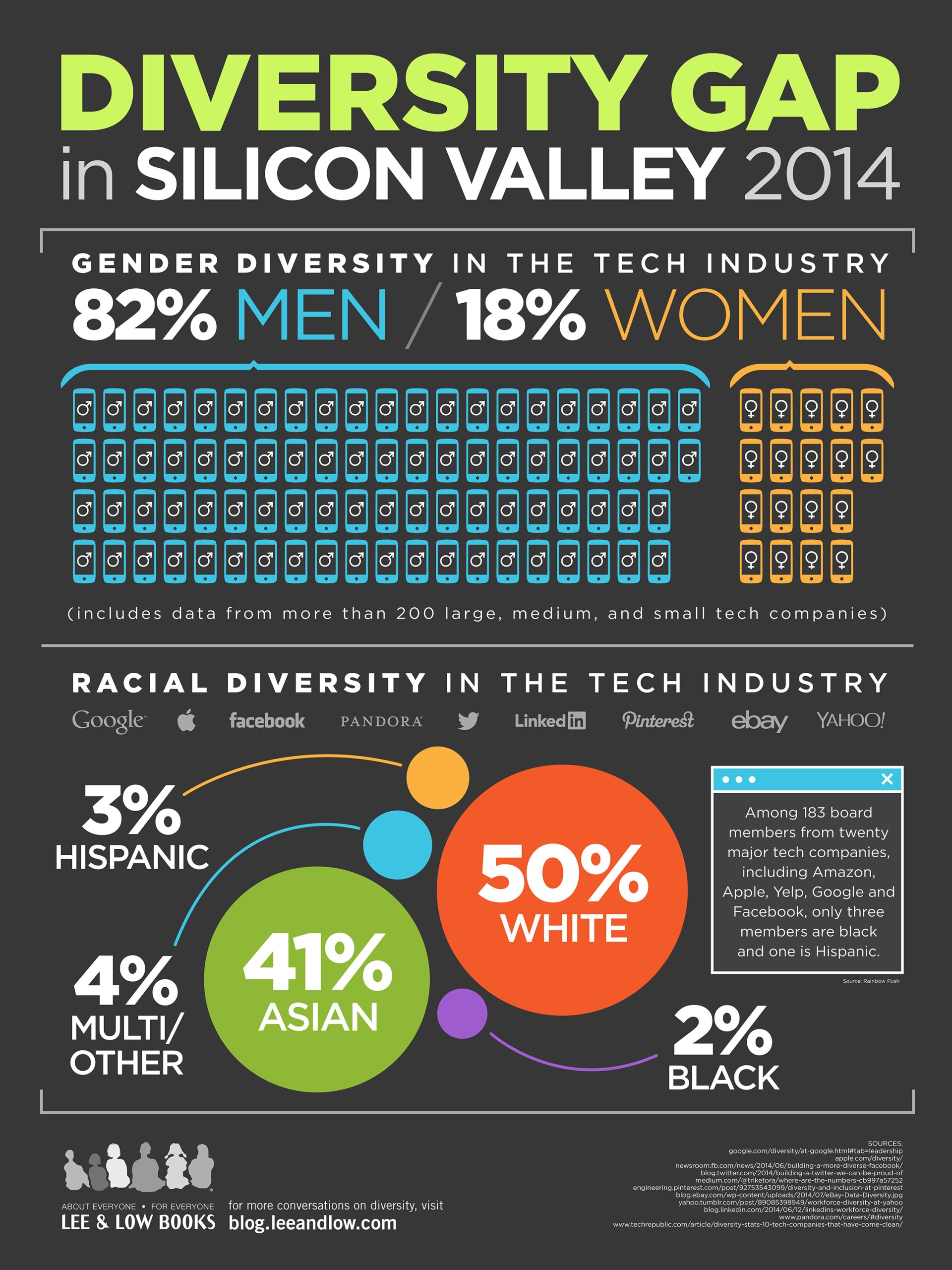Silicon Valley has been the darling of the US economy for decades. Creativity, leadership, risk taking, and hard work are all attributes of American innovation at its finest. Though lauded as a true meritocracy by the business world, the truth is that Silicon Valley that suffers from a similar lack of representation among women and people of color as other industries. In our past Diversity Gap studies of the Academy Awards, the Tony Awards, the Emmy Awards, the children’s book industry, The New York Times Top 10 Bestseller List, Sci-Fi and Fantasy Films, and US politics, we have shown that there is a disturbingly consistent lack of diversity across the boards.
Then something revolutionary happened—more tech companies came on board and offered their numbers. Soon it wasn’t just small and mid-size companies, it was Apple, Google, and Facebook. In all, more than two hundred tech companies of all sizes have now publicly released statistics about diversity among staff—a bold display of transparency. In response, several companies have stepped forward with solutions, Google has offered to pay for 1,000 women to take coding classes, and Intel has committed $300 million to diversifying its workforce in three to five years. While Silicon Valley has many of the same diversity problems as everyone else, it is addressing the problem in very real and practical ways from which other industries (like publishing) can learn a lot. We spoke to three tech industry professionals and a diversity expert for their thoughts:

Kimberly Bryant is Founder and Executive Director of Black Girls CODE, a non-profit organization dedicated to “changing the face of technology” by introducing girls of color (ages 7–17) to the field of technology and computer science with a concentration on entrepreneurial concepts.

Rosalind Hudnell, Vice President Human Resources, Chief Diversity Officer, Intel Corporation, was recognized in Black Enterprise magazine’s 2011 list of “Top Executives in Diversity.” This recognition places Rosalind in an elite group of diversity officers and vice presidents that are considered to be the nation’s highest-ranking and most influential executives leading corporate diversity initiatives.

Leah Smiley is President and Founder of The Society for Diversity, the #1 professional association for diversity and inclusion. With 15 years of corporate human resources experiences and more than 10 years of experience in diversity, Smiley has served over 400 members and thousands of non-members through the Society for Diversity since 2009. She also has extensive training and consulting experience in every sector, allowing her to obtain publicity in traditional, and social, media outlets throughout the world.

Tracy Chou is a software engineer and tech lead at Pinterest, currently on the monetization team; she was previously at Quora, also as an early engineer there. With initiatives in the workplace and the community, Tracy works actively to promote diversity in the tech industry and has pushed for greater transparency and discussion on the topic with a Github project crowdsourcing data on women in software engineering. She was named Forbes Tech 30 under 30 in 2014 and recently profiled in Vogue for her work.
THE PIPELINE SOLUTION
Jason Low: Let’s start with Kimberly Bryant and Black Girls CODE. Kimberly, why don’t more parents and teachers encourage girls to pursue and excel in STEM subjects and careers? Where does this gender bias come from and why does it persist?
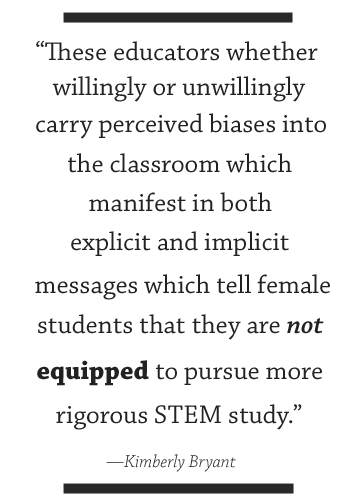
Kimberly Bryant: There are many issues why parents of students from underrepresented communities don’t encourage their girls to pursue STEM subjects and careers. Some of the reasons are culturally based and rooted in the perception of the industry as a male dominated and female “unfriendly” field. These parents are more apt to direct their girls into career fields that are perceived as safer or more welcoming to women (such as medicine, healthcare, teaching, etc). So the stereotypes influence parental guidance. These communities of parents are also unaware of the opportunities, which exist in a more broader section of STEM fields. In this case the lack of exposure to STEM careers is a large driver in parents lack of focus on these opportunities for their girls.
In terms of educators the issues seem to be a bit different. There is still quite a bit of implicit bias exhibited by educators throughout the K–12 pipeline and beyond which reveals itself in some educators becoming the defacto “gate keepers” to a career path in tech for girls. These educators whether willingly or unwillingly carry perceived biases into the classroom which manifest in both explicit and implicit messages which tell female students that they are not equipped to pursue more rigorous STEM study. We’ve heard many cases where girls are discouraged from pursuing classes in technology and science and instead steered into a less rigorous curriculum path. This gender bias is present throughout our society so it also reveals itself in this way in the classroom. There is a perception that one is “born” with talent innately to pursue rigorous study in the field rather than fluidity in STEM subject matter being a learned skill.
JL: I noticed that there is a NY chapter of Black Girls CODE. I read that BGC has worked with 3,000 girls so far and has a goal of working with a million girls. In order to make a dent in the lack of gender and ethnic diversity in technology will it be necessary to have a Black Girls CODE chapter in every major city? What will it take to replicate the Black Girls CODE model across the country?
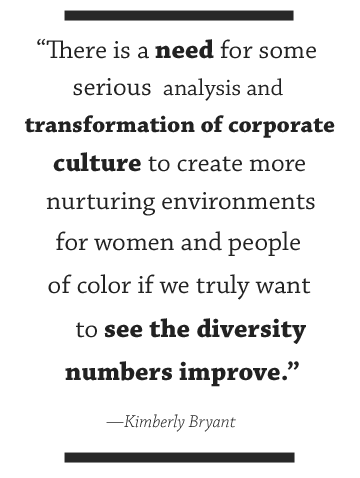
KB: We do believe it will be necessary to have a Black Girls CODE chapter in multiple cities across the US in order to reach our goal of teaching one million girls of color to code by 2040. In fact we try to model our organization as the “girl scouts of technology” with this very idea in mind—our organization must become widely available and synonymous with girls of color in tech in urban, rural, and suburban communities across the nation in order to reach this goal. It’s a daunting task to say the least but definitely achievable as we continue to seek support for our growing list of chapter across the country and internationally as well. It will take many additional partners stepping up to support this work across multiple sectors including philanthropic entities, government, and corporate partners to make this reach possible. Yet even if we reach this goal we will only reach a fraction of the girls from underrepresented communities that will compose our population demographics by the year 2040, which highlights the fact that this is not a problem that one organization alone can solve. We stress the need for coding to be taught in all schools in addition to the work that organizations such as Black Girls CODE is doing in the non-profit sector.
JL: There have been a number of recent articles that show that 41% of women leave technology mid career as opposed to 17% of men. This is an equally troubling trend given that organizations like yours are working so hard to make qualified women available for the industry to hire. What are some basic solutions to retain the future pipeline of women coming into the industry?
KB: When we look at the issue of diversity in tech today the issue is often described as a “pipeline” problem. In most cases when this terminology is used it directs the focus to the K–12 sector as representing the tech pipeline. I believe this is an incorrect description of the tech pipeline. If we describe the tech pipeline as more circular and encompassing in this analogy it would incorporate the K–12 segment, post-graduate students, and career women in technology. In this description of a much broader pipeline I believe it becomes very clear that we have leaks in every conceivable segment of this pipeline. With attrition rates for both women and minorities at such high levels it really is indicative of a much more endemic issue in tech culture and structure than simply an early pipeline issue. So although the work of orgs such as Black Girls CODE can go far in terms of front-loading the pipeline, we are preparing these students to go on to careers in technology. If the companies that meet them when they begin their careers are not culturally sensitive to valuing and supporting the career growth and needs for a diverse pool of employees then we will continue to see the high attrition numbers described above. There is a need for some serious analysis and transformation of corporate culture to create more nurturing environments for women and people of color if we truly want to see the diversity numbers improve. One key facet of this transformation specifically is to see broader representation of women and minorities across all levels of the corporation (from the board room to entry level) and then a transformation in corporate culture to a more diverse and culturally sensitive environment.
THE DIVERSITY INVESTMENT
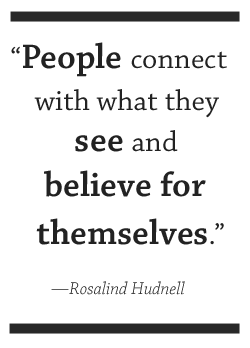
JL: Next up is Rosalind Hudnell. Rosalind, for many years, technology leaders would always state that the industry was a true meritocracy and that the applicants of color and women candidates were simply not out there to hire. Being that Intel is now leading the charge to diversify its workforce, what kinds of programs, partnerships, and/scholarships will Intel be investing in to develop future diverse applicants who will be interviewing for jobs in technology in 3-5 years?
Rosalind Hudnell: Intel has a long-standing history of diversity and full inclusion work and we’ve learned a great deal over the last decade. We intend to apply these learnings in a more intentional way to achieve our diversity goals in hiring, but also in retaining and growing our people, especially women and under-represented program. Research shows that there is a significant dropout between year 1 and year 2 of engineering programs. When we learned this, we launched our Stay With It engineering program. We believe that we can shift students to staying with these careers if we share more of why these careers matter and make a difference while also providing an environment that inspires and gives practical hands on experience with role models and mentors. People connect with what they see and believe for themselves.
JL: $300 million is a substantial investment on Intel’s part toward diversity. What are the advantages of having a more diverse workforce? How will having more equal representation in Intel’s ranks result in better products and a more successful company?
RH: The business case for diversity and inclusion has been widely researched and proven. We believe that full inclusion, without artificial barriers or bias, is critical to Intel’s long-term business success and essential to achieving our vision of creating the world’s best smart and connected technology. Doing so will help us better reflect our customers, consumers and global marketplace. Creating an inclusive culture that consistently leverages the full range of all our employees’ perspectives and capabilities is critical to innovation and achieving our business objectives.
CONFRONTING THE LACK OF DIVERSITY
JL: Now some questions for Leah Smiley. Leah, past and current diversity efforts have mostly been driven by people of color and have largely excluded white people. Last year, you wrote some observations/advice regarding Google’s diversity efforts. “Make current staff part of the solution” was one of your tips. Please expound upon this for us.
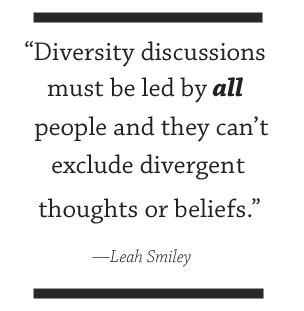
Leah Smiley: It’s important to include current staff when transforming the cultural fabric of an organization. But I admonish you to proceed with caution because the knee-jerk reaction can be worse than inaction.
Often times, an organization will gather all of the diverse people and take a lot of pictures for marketing purposes, or they will promote a person from an under-represented group to the role of Chief Diversity Officer. These are examples of knee-jerk reactions—and should be avoided at all costs.
A better approach would be to: (1) clearly define the purpose of the diversity officer role (i.e., how does it correspond to organizational goals); (2) seek to fill the position with smart people who have the skills to accomplish intended results—regardless of race/gender/etc.; (3) create high-profile and high-potential diversity councils or employee resource groups to support the diversity officer role.
Diversity discussions must be led by all people and they can’t exclude divergent thoughts or beliefs. Education and training can always supplement any person who fulfills the role, but there is no substitute for credibility. Placing smart people in the Chief Diversity Officer role (regardless of their differences or similarities) allows the organization to effect genuine change without sacrificing professional integrity.
JL: Addressing inequality issues is often times referred to as necessary but “messy work”. What are some of the most ideal factors that can make diversity work (a) successful (b) sustainable, and (c) lasting?
LS: I once presented an employee benefits presentation where I was tasked with delivering the bad news: your benefits are changing, your cost are going up and you’re not getting a raise. I did so many of these talks in the past that I could deliver a great message with my eyes closed. But one tech group didn’t receive my message too well. Although they were highly compensated, in comparison to every other meeting I facilitated, these employees went bananas! I didn’t know where I went wrong. When I talked to my boss afterwards, he schooled me about ignoring the elephant in the room. The bigger issue was that the company was in financial trouble, and the benefits were just one of many that had recently changed for the worse. In my arrogance, I proceeded with a “business as usual” attitude, and things went very wrong quickly.
In the same way, addressing “inequality” can be messy if you are not dealing with the bigger issues, which may include, but are not limited to:
(1) Perceptions of management (i.e., Is management too lax? Is the management team akin to the “good ‘ole boys club”?)
(2) Communication (i.e., Was this person hired because he is black or because he is the best qualified for the job? Why was the Office of Diversity created in the first place?)
(3) Informal rules (i.e., Is hiring based on “who you know” or is there a formal process? Is discipline informal or are there written policies?)
DIVERSITY ACTIVISM MEANS EVERYONE
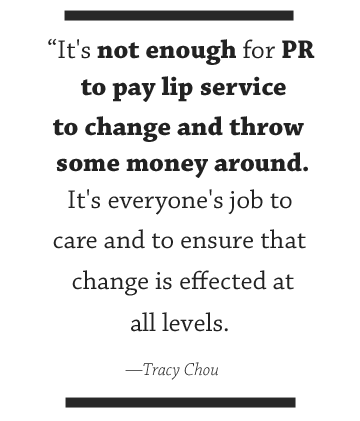
JL: The last question is for Tracy Chou. Tracy, your initiative to create a gender baseline for the Silicon Valley’s workforce was an important first step toward improving representation. One question: Pinterest’s diversity numbers among tech workers has grown from 13% to 20%. This news, along with Intel’s recent announcement of committing $300 million dollars toward diversifying their workforce is great news for diversity. What do you think the future looks like for addressing this issue and are you encouraged?
Tracy Chou: The first part of addressing this issue, which is already underway, is heightened awareness and sensitivity to it. We still have a long way to go on this front, though. In the immediate future, we’re still working towards broad-based awareness, a more nuanced understanding of pipeline and retention issues, cutting across gender, race, and other lines, to drive a deep commitment to change. It’s not enough for PR to pay lip service to change and throw some money around. It’s everyone’s job to care and to ensure that change is effected at all levels. To that end, the next part of addressing this issue is an orientation towards outcomes; we need to try different approaches, learn which ones work and which ones doesn’t, and iterate. This will all go much faster if we are honest with each other and willing to work together. In the same way that publishing statistics on current demographics has been critical to establish a broad baseline and thus our starting point, continued transparency on the various strategies and tactics being deployed, and their efficacy, is important for us as an industry to figure out the right direction to go and how to accelerate our movement in that direction.
I’m generally very encouraged by the heightened discourse on diversity issues in the past year; it’s starting to reach prominence even in mainstream media. I see momentum and I am hopeful we can capitalize on it.
—
Special thanks to all who contributed. More to come.
Read more Diversity Gap studies on:
The Tony Awards
The Emmy Awards
The Academy Awards
The children’s book industry
The New York Times Top 10 Bestseller List
US politics
Sci-Fi and Fantasy Films
Further resources on how to teach content and visual literacy using Lee & Low Books’ infographics series on the Diversity Gap:
Using Infographics In The Classroom To Teach Visual Literacy
For press inquiries or permission to reprint, please contact Hannah Ehrlich at hehrlich[at]leeandlow[dot]com.









